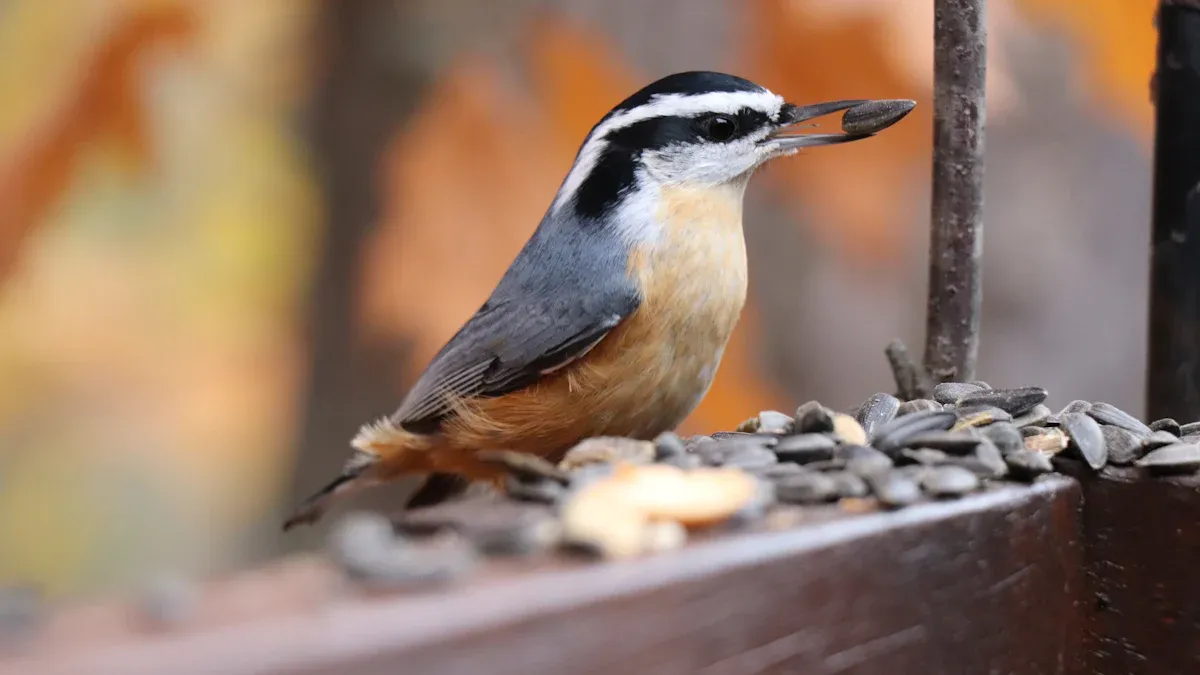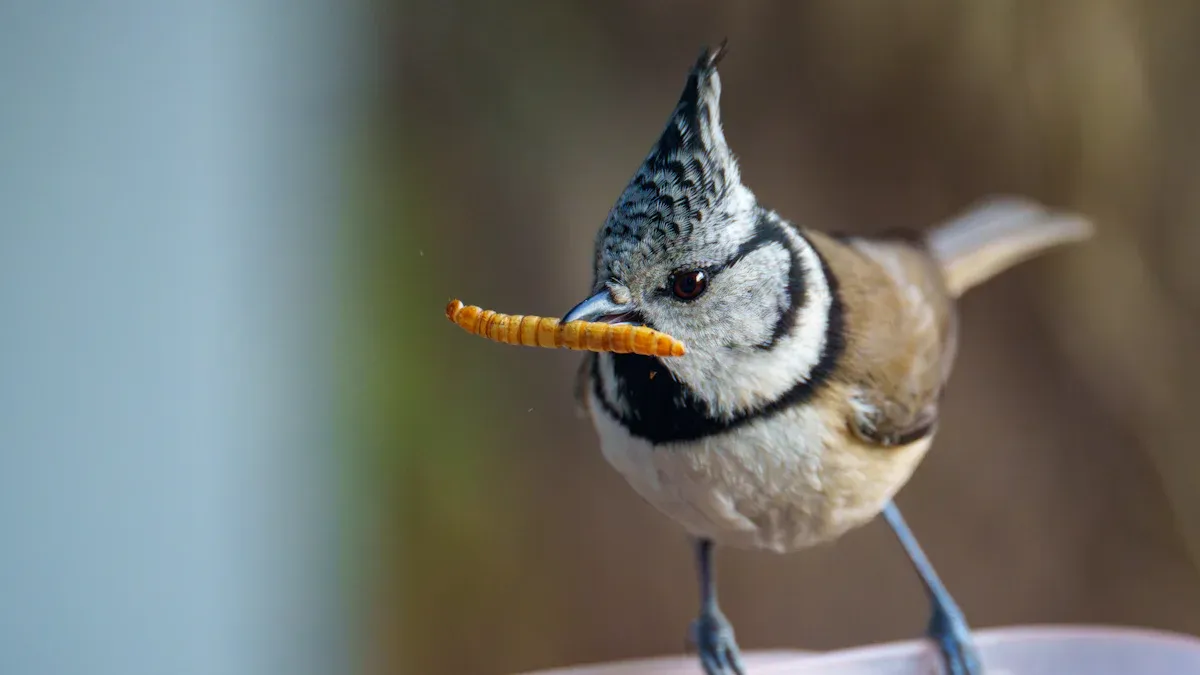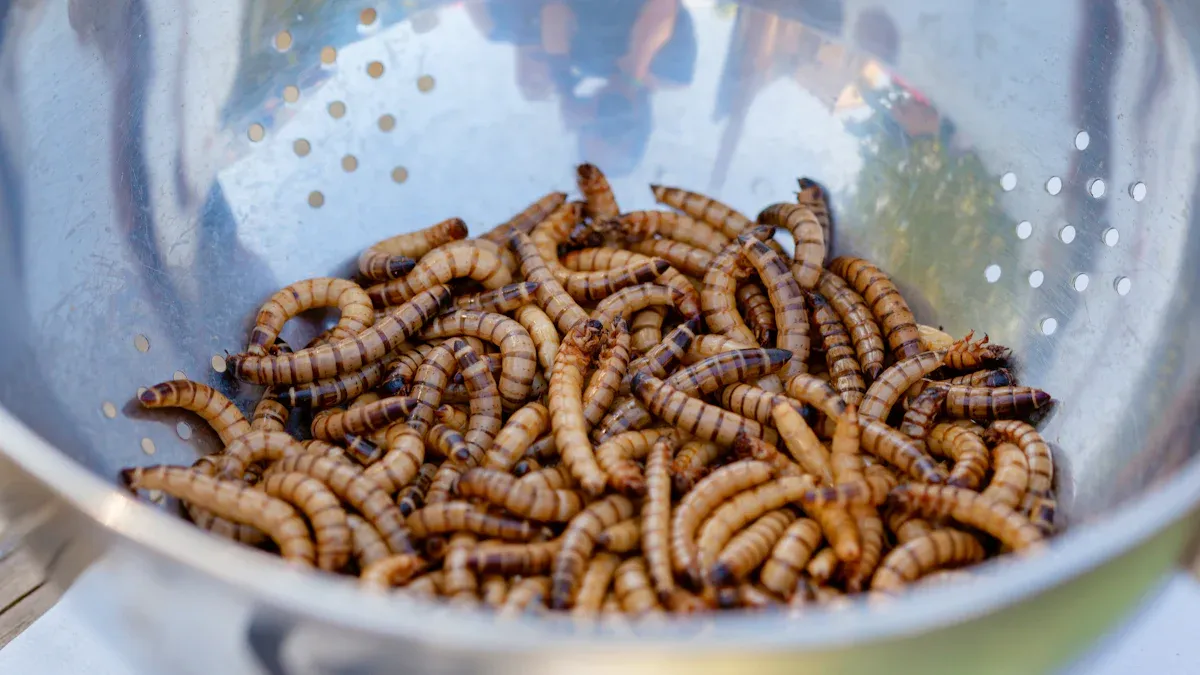
Mealworms are a fantastic treat for wild birds. They’re packed with protein—live mealworms contain 20%, while dried ones boast an impressive 53%. Since 80% of bird families eat insects, mealworms are a natural choice. Offering this bird food wild birds love can attract a variety of species to your backyard.
Key Takeaways
- Mealworms are healthy snacks for wild birds. They give birds protein and fat, which help them stay strong, especially in winter or when nesting.
- Use flat feeders or spread mealworms on the ground to bring birds closer. Clean feeders often and refill them to keep birds coming back.
- Begin with a small amount of mealworms to avoid wasting food. Slowly add more as birds get used to eating them. Store mealworms the right way to keep them fresh.
Types of Mealworms and Their Benefits

Live Mealworms
Live mealworms are a favorite among many wild birds. They’re soft, moist, and easy to digest, making them perfect for young birds or species that prefer fresh food. Birds like bluebirds, chickadees, and woodpeckers often flock to feeders offering live mealworms. These mealworms are especially helpful during breeding seasons when birds need extra protein to feed their chicks.
Live mealworms also mimic the natural diet of wild birds. They’re rich in moisture (62%) and contain about 20% protein, 13% fat, and essential minerals like calcium and magnesium. This makes them an excellent choice for supporting birds during times when natural insects are scarce.
Tip: To make live mealworms more appealing, place them in a shallow tray feeder where birds can easily spot them.
Dried Mealworms
Dried mealworms are a convenient alternative to live ones. They don’t require refrigeration and have a longer shelf life, making them ideal for busy bird enthusiasts. These mealworms are packed with nutrients, offering 53% protein and 28% fat, which are crucial for wild birds during winter or migration.
Another advantage of dried mealworms is their versatility. You can mix them with other bird food wild birds enjoy, like seeds or suet, to create a balanced meal. Some dried mealworms are even fortified with extra vitamins and minerals, boosting their nutritional value.
Note: If you want to make dried mealworms more appealing, soak them in water to rehydrate them. This makes them softer and easier for birds to eat.
Nutritional Value of Mealworms
Mealworms, whether live or dried, are a powerhouse of nutrition. They’re high in protein, fat, and essential nutrients that help birds stay healthy and energetic. During cold weather, the extra fat in mealworms helps birds maintain their body heat. Protein is vital for young birds, egg-laying females, and those feeding their chicks.
Here’s a quick comparison of the nutritional content of live and dried mealworms:
| Type of Mealworm | Moisture | Lipid (Fat) | Protein | Ash | Carbohydrate |
|---|---|---|---|---|---|
| Live Mealworms | 62% | 13% | 20% | 1.5% | 3.1% |
| Dried Mealworms | 5% | 28% | 53% | 4.1% | 8.5% |

By offering mealworms, you’re providing bird food wild birds need to thrive, especially during challenging seasons.
Feeding Methods for Bird Food Wild Birds
Using Tray Feeders
Tray feeders are one of the easiest ways to offer mealworms to wild birds. These feeders make the food highly visible, which helps attract birds quickly. Look for tray feeders with features like tall sides to keep mealworms from crawling out and drainage holes to prevent water from pooling. Some even come with roofs or baffles to protect the mealworms from rain.
| Feature | Benefit |
|---|---|
| Tall sides | Prevents mealworms from crawling out |
| Roof or baffle | Protects mealworms from rain, preventing drowning or mold |
| Drainage holes | Allows excess water to escape, keeping mealworms dry |
| Tamper-resistant features | Discourages squirrels and other pests from accessing the food |
Place your tray feeder in an open area where birds can easily spot it. If you want to attract specific species, consider using specialized mealworm feeders designed for their needs.
Tip: Keep the feeder clean and refill it regularly to maintain a steady supply of fresh mealworms.
Ground Feeding
Some birds prefer to feed on the ground, so scattering mealworms in open spaces can be a great option. This method mimics how birds forage in the wild, making it feel natural for them. Choose a dry, safe spot away from predators and heavy foot traffic.
To improve the health and survival rates of wild birds, you can mix mealworms with other nutritious options like hulled sunflower seeds or millet. These foods are easy for birds to process and provide essential nutrients.
Note: Avoid overfeeding on the ground to prevent attracting pests like rodents.
Mixing Mealworms with Other Bird Food
Mixing mealworms with other bird food wild birds enjoy is a smart way to create a balanced diet. Combine them with black oil sunflower seeds, which are rich in fat and highly preferred by many bird species. You can also add millet or suet for variety.
For an extra boost, consider mealworms enhanced with Lactobacillus kimchicus. Studies show that this probiotic improves gut health, leading to heavier nestlings and better survival rates. This combination not only supports the birds’ health but also keeps them coming back for more.
Pro Tip: Experiment with different mixes to see what works best for the birds in your area.
Birds That Eat Mealworms

Common Backyard Birds
Mealworms are a favorite treat for many common backyard birds. You’ll often see species like chickadees, cardinals, nuthatches, and woodpeckers flocking to feeders stocked with mealworms. These birds love mealworms because they mimic the insects found in their natural diets. American Robins are another frequent visitor, especially when they’re raising their young.
If you’re just starting out, try placing mealworms in a tray feeder or mixing them with other bird food wild birds enjoy. This will help attract a variety of species to your yard. Once they discover the mealworms, they’ll keep coming back for more!
Seasonal Visitors
Mealworms can also attract seasonal visitors to your yard. During migration periods, birds like orioles and bluebirds rely on high-protein foods to fuel their long journeys. Offering mealworms during these times can make a big difference.
Here’s why mealworms are perfect for seasonal visitors:
- They’re clean and easy to eat.
- They provide essential nutrients during cold winters and spring reproduction.
- They support fledgling birds, helping them grow strong and healthy.
By offering mealworms year-round, you can support a diverse range of birds and even attract new species that might not be interested in seeds alone.
Birds That Benefit Most from Mealworms
Some birds benefit more from mealworms than others. Species like American Robins and Bluebirds need animal matter in their diets to thrive. Mealworms provide the protein and fat these birds require, especially during breeding and nesting seasons.
If you want to help these birds, consider adding mealworms to your feeding routine. They’re a simple way to give birds the nutrition they need while enjoying the beauty of nature in your backyard.
Practical Tips for Feeding Mealworms
Start with Small Quantities
When you’re just starting out, it’s best to offer mealworms in small amounts. Birds see mealworms as a treat rather than a staple, so a handful is usually enough. This approach prevents waste and keeps pests like rodents away. During spring, you can increase the quantity slightly since birds need more protein for nesting and feeding their young.
Tip: If you notice birds finishing the mealworms quickly, gradually increase the amount until you find the right balance.
Proper Storage for Mealworms
Storing mealworms correctly ensures they stay fresh and nutritious. For live mealworms, keep them in a jar with breathing holes and place them in the fridge. The cold slows their activity, helping them last longer. Avoid freezing them, as this can kill them. Dried mealworms, on the other hand, should be stored in a dark, dry place at room temperature. They can last anywhere from 6 to 15 months if stored properly.
Note: Proper storage not only preserves the nutritional value but also prevents spoilage and waste.
Cleaning and Maintaining Feeders
Clean feeders regularly to keep your feathered visitors healthy. Dirty feeders can spread diseases among birds. Use warm, soapy water and a brush to scrub away debris. Disinfect the feeder with a mild bleach solution, then rinse thoroughly and let it dry before refilling.
| Study Title | Findings |
|---|---|
| Bird-feeder cleaning lowers disease severity in rural but not urban birds | Regular cleaning reduces gut coccidian loads in rural male house finches, improving their health. |
Tip: Make cleaning a weekly habit to minimize health risks for wild birds.
When and How Often to Feed Mealworms
Offer mealworms occasionally as a special treat. During spring, you can feed them more often to support birds during egg-laying and chick-rearing. Dried mealworms can be offered year-round but should still be given in moderation.
Pro Tip: Place mealworms in a visible spot to attract birds quickly, especially when natural food is abundant.
Addressing Common Concerns
Training Birds to Eat Mealworms from Your Hand
Hand-feeding wild birds can be a magical experience, but it takes patience and the right approach. Start by placing mealworms in a tray or feeder near your usual feeding station. Gradually move the feeder closer to where you sit. Once the birds feel comfortable, offer mealworms in your open palm.
Here’s a step-by-step guide to help you succeed:
- Begin with a tray of mealworms and a signal, like a whistle, to attract birds.
- After a few days, sit nearby with a blue cloth on your lap and the tray on top.
- Once birds are used to your presence, remove the tray and place mealworms directly in your hand.
- Stay still and avoid sudden movements to build trust.
Note: Always wash your hands before handling mealworms to keep the birds safe.
Offering Mealworms Year-Round
Mealworms are a valuable food source throughout the year. In winter, their high fat content helps birds stay warm. During spring and summer, the protein supports egg-laying and chick-rearing.
- Winter: Offer dried mealworms to provide energy for cold nights.
- Spring: Live mealworms are ideal for feeding hungry chicks.
- Summer: Use mealworms sparingly to avoid dependency.
Mealworms are a supplement, not a replacement for a bird’s natural diet.
Preventing Pests and Unwanted Animals
Mealworms can attract pests like rodents if not managed properly. To avoid this:
- Use feeders with tamper-resistant features.
- Avoid scattering mealworms on the ground.
- Clean up uneaten mealworms daily.
By following these tips, you can enjoy feeding wild birds without worrying about unwanted visitors.
Feeding mealworms to wild birds is a simple way to support nature while enjoying birdwatching. Start small and experiment with different feeding methods.
Tip: Choose live or dried mealworms based on your schedule and the birds’ needs.
With proper care, mealworms can become a favorite treat for your feathered visitors!
FAQ
Can I feed mealworms to baby birds?
Yes, mealworms are great for baby birds. Live mealworms provide moisture and protein, which help chicks grow strong. Offer them during nesting season for the best results.
How do I stop squirrels from eating mealworms?
Try squirrel-proof feeders with baffles or weight-sensitive perches. Place feeders away from trees or fences. Clean up spilled mealworms to avoid attracting unwanted visitors.
Are mealworms safe for all bird species?
Most insect-eating birds love mealworms. However, avoid overfeeding. Mealworms should complement a bird’s diet, not replace it. Balance them with seeds, fruits, or suet for variety.
Tip: Always observe how birds respond to mealworms and adjust your feeding routine accordingly. 🐦


